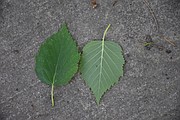Western paper birch: A tree whose bark peels into sheets
One of the first deciduous trees I learned to identify in Boundary County was the western paper birch. I was fascinated with the white cream bark that peels into sheets, and the oval leaves with double toothed edges.
Common names of the western paper birch are white birch, silver birch and canoe birch. The scientific name is Betula papyrifera (papyrifera means “paper-bearing,” referring to the papery bark.)
The paper birch tree is short-lived by tree standards, shade-intolerant, a pioneer species. It rapidly colonizes open, disturbed sites created by wildfire, blow-downs or avalanche but lasts only one generation before it is replaced by shade-tolerant conifers or northern hardwoods. The birch tree is native to northern North America. Paper birch is named for the tree’s thick white bark, which often peels in paper like layers from the trunk. The wood is often used for pulpwood and firewood.
Paper birch grows best on deep, well-drained to moderately well-drained, sandy or silty soil. It is often found in moist upland soils and cutover lands. It is frequently found in nearly pure stands.
The paper birch is often a several-stemmed, deciduous tree that reaches 90-120 feet tall. It is a fast-growing tree and grows as much as two feet per year. The paper birch’s size at 60 years is 50-70 feet tall and one to two feet in diameter.
Wildlife is attracted to the white paper birch. The birch produces a sap that woodpeckers love. An enterprising woodpecker pokes holes in the paper birch bark to retrieve the sap, enabling hummingbirds and squirrels to swoop in and delight in the treat made possible by the woodpeckers. Moose, elk and white-tailed deer will eat the leaves and bark from the trunk, as will porcupines.
The leaves of the paper birch are oval with pointed tips, and the edges are coarse, irregular, and double-toothed, two to four inches long, with a pale green color turning yellow in autumn.
The bark is reddish to coppery brown when young. Upon maturation the bark turns to white or cream, with conspicuous dark, horizontally elongated lines. The bark peels into sheets exposing a reddish orange inner bark that blackens with age, deeply fissured and black at the base of old trees. It is important to not peel the bark of living trees, as it can scar and actually kill trees.
The western paper birch is used for ice-cream sticks, toothpicks, and toys. Native Americans made canoes by stretching strips of bark over a cedar frame. They also made paper birch bark into baskets, storage containers, mats, baby carriers, moose and bird calls, torches, household utensils, bows, arrow, snowshoes, sleds and other items.
The lifespan of a western paper birch in the wild is between 80-120 years.
Enjoy Boundary County and all its beautiful trees!



